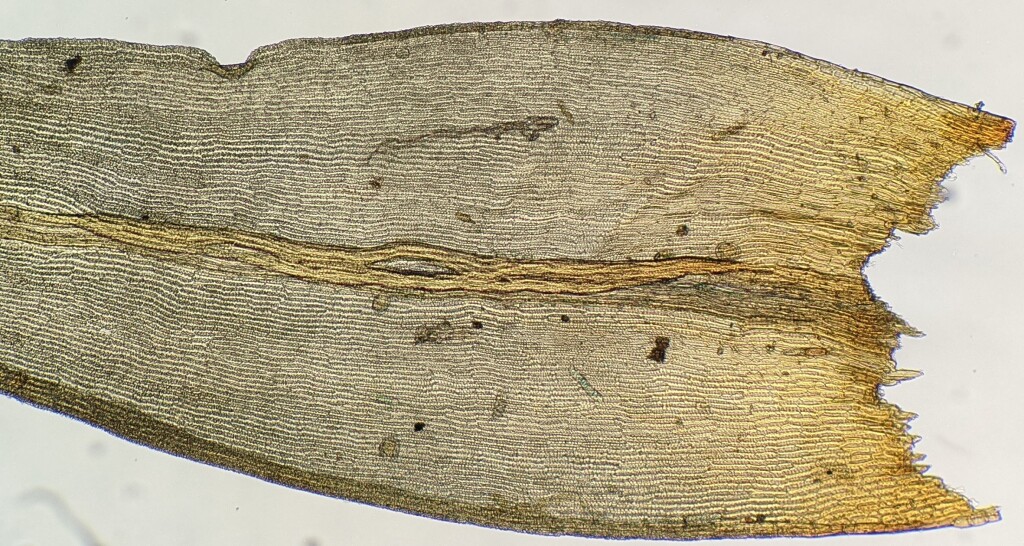Racomitrium
Dioicous. Asexual reproduction rarely by gemmae on abaxial costa (not in Victoria). Cushions, mats or turves on soil or rock. Stems erect, creeping or decumbent, dichotomously, irregularly or subpinnately branched, rarely simple (not in Victoria), glabrous or with rhizoids in basal half; central strand absent. Leaves triangular, ovate-lanceolate or elliptic (not in Victoria), erecto-patent to wide-spreading when moist, appressed to erecto-patent when dry, sometimes also falcate-secund; apices acuminate, acute or obtuse (not in Victoria), with or without a hairpoint; hairpoint hyaline, smooth or papillose, sometimes decurrent along margins of leaf where dentate; costa subpercurrent to excurrent or rarely terminating well below apex (not in Victoria) near mid-leaf or in apical half; margins entire or dentate near apex, recurved, often with a border of pellucid, straight-walled cells at base; laminal cells quadrate to rectangular, becoming more elongate toward base, straight, sinuose or nodulose walled, smooth, or papillose with flat-topped papillae over lateral walls or conic papillae over lumen (not in Victoria), uni- or multistratose; alar cells not differentiated or differentiated, enlarged, hyaline or yellowish and sometimes forming decurrent auricles (not in Victoria). Cladocarpous. Setae straight, smooth or papillose. Capsule erect, symmetric, ovoid, ellipsoid or obolid to cylindric, exserted, smooth or obscurely striate, with an annulus. Calyptra mitrate, smooth or papillose at apex (not in Victoria). Operculum rostrate from conic base. Peristome teeth divided midway or more into 2–3 filaments or rarely entire (not in Victoria), with a low or high basal membrane.
Cosmopolitan, but most diverse at higher latitudes, with around 80 species; four species in Victoria.
Racomitrium has alternatively been recognised in a much narrower circumscription that is restricted to species with papillose laminal cells and setae, and hyaline awns that are decurrent and dentate along the margins (Ochyra et al. 2003). In this circumscription Racomitrium is represented in Victoria by R. pruinosum (Wilson) Müll.Hal. The remaining species are distributed among the genera Codriophorus, Niphotrichum and Bucklandiella, which contains the remaining Victorian species. However, the major lineages recovered in phylogenies of chloroplast and nuclear DNA sequences do not correspond to these segregate genera but instead correspond to sectional divisions of Racomitrium (Larraín et al. 2013). Consequently, Larraín et al. (2013) advocate for Racomitrium to be recognised in its broad circumscription. Sawicki et al. (2015) argue in favour for retaining the segregate genera based on their apparent monophyly in their phylogeny based on entire mitochondrial genomes. However, species sampling was far fewer and the species selected for each segregate genus, with one exception, were shown to be close relatives by Larraín et al. (2013), so the placement of only one species had to change to present the segregate genera as monophyletic. Additionally, the topology of their tree was also likely to be highly affected by their choice of outgroup that was far more distantly related than the Grimmiaceae outgroups used by Larraín et al. (2013). Regardless of whether the segregate genera are monophyletic, Racomitrium is easily recognisable and monophyletic in the broader circumscription (Hernández-Macqueda et al. 2008; Larraín et al. 2013) and is followed here.
 Spinning
SpinningHernández-Maqueda, R.; Quandt, D.; Werner, O.; Muñoz, J. (2008). Phylogeny and classification of the Grimmiaceae/Ptychomitriaceae complex (Bryophyta) inferred from cpDNA. Molecular Phylogenetics and Evolution 46: 863–877.
Larraín, J.; Quandt, D.; Stech, M.; Muñoz, J. (2013). Lumping or splitting? The case of Racomitrium (Bryophytina: Grimmiaceae). Taxon 62: 1117–1132.
Ochyra, R.; Zarnowiec, J.; Bednarek-Ochyra, H. (2003). Census catalogue of Polish mosses.. Biodiversity of Poland 3: 1–372.
Sawicki, J.; Szczecińska, M.; Bednarek-Ochyra, H.; Ochyra, R. (2015). Mitochondrial phylogenomics supports splitting the traditionally conceived genus Racomitrium (Bryophyta: Grimmiaceae). Nova Hedwigia 100: 293–317.


